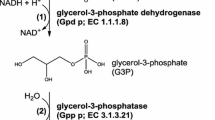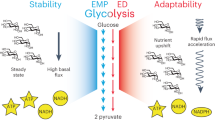Abstract
The understanding of control of metabolic processes requires quantitative studies of the importance of the different enzymatic steps for the magnitude of metabolic fluxes and metabolite concentrations. An important element in such studies is the modulation of enzyme activities in small steps above and below the wild-type level. We review a genetic approach that is well suited for both Metabolic Optimization and Metabolic Control Analysis and studies on the importance of a number of glycolytic enzymes for metabolic fluxes in Lactococcus lactis. The glycolytic enzymes phosphofructokinase (PFK), glyceraldehyde-3-phosphate dehydrogenase (GAPDH), pyruvate kinase (PYK) and lactate dehydrogenase (LDH) are shown to have no significant control on the glycolytic flux in exponentially growing cells of L. lactis MG1363. Introduction of an uncoupled ATPase activity results in uncoupling of glycolysis from biomass production. With MG1363 growing in defined medium supplemented with glucose, the ATP demanding processes do not have a significant control on the glycolytic flux; it appears that glycolysis is running at maximal rate. It is likely that the flux control is distributed over many enzymes in L. lactis, but it cannot yet be excluded that one of the remaining glycolytic steps is a rate-limiting step for the glycolytic flux.
Similar content being viewed by others
References
Andersen HW, Solem C, Hammer K& Jensen PR (2001a) Twofold reduction of phosphofructokinase activity in Lactococcus lactis results in strong decreases in growth rate and in glycolytic flux. J. Bacteriol. 183: 3458–3467.
Andersen HW, Pedersen MB, Hammer K& Jensen PR (2001b) Lactate dehydrogenase has no control on lactate production but has a strong negative control on formate production in Lactococcus lactis. Eur. J. Biochem. 268: 6379–6389.
Bakker BM, Michels PA, Opperdoes FR& Westerhoff HV (1999) What controls glycolysis in bloodstream form Trypanosoma brucei? J. Biol. Chem. 274: 14551–14559.
Bolotin A, Wincker P, Mauger S, Jaillon O, Malarme K, Weissenbach J, Ehrlich SD& Sorokin A (2001) The complete genome sequence of the lactic acid bacterium Lactococcus lactis ssp. lactis IL1403. Genome Res 11: 731–753.
Brøndsted L& Hammer K (1999) Use of the integration elements encoded by the temperate lactococcal bacteriophage TP901-1 to obtain chromosomal single-copy transcriptional fusions in Lactococcus lactis. Appl. Environ. Microbiol. 65: 752–758.
Cocaign-Bousquet M, Garrigues C, Loubiere P& Lindley ND (1996) Physiology of pyruvate metabolism in Lactococcus lactis. Antonie Van Leeuwenhoek 70: 253–267.
Cornish-Bowden A, Hofmeyr J-HS& Cardenas ML (1995) Strategies for manipulating metabolic fluxes in biotechnology. Bioorg. Chem. 23: 439–449.
Crow VL& Pritchard GG (1977) Fructose 1,6-diphosphateactivated L-lactate dehydrogenase from Streptococcus lactis: kinetic properties and factors affecting activation. J. Bacteriol. 131: 82–91.
de Felipe FL, Kleerebezem M, de Vos WM& Hugenholtz J (1998) Cofactor engineering: a novel approach to metabolic engineering in Lactococcus lactis by controlled expression of NADH oxidase. J. Bacteriol. 180: 3804–3808.
de Ruyter PG, Kuipers OP& de Vos WM (1996) Controlled gene expression systems for Lactococcus lactis with the food-grade inducer nisin. Appl. Environ. Microbiol. 62: 3662–3667.
Fordyce AM, Moore CH& Pritchard GG (1982) Phosphofructokinase from Streptococcus lactis Methods. Enzymol. 90: 77–82.
Fordyce AM, Crow VL& Thomas TD (1984) Regulation of product formation during glucose or lactose limitation in nongrowing cells of Streptococcus lactis. Appl. Environ. Microbiol. 48: 332–337.
Fraenkel DG (1968) The accumulation of glucose-6-phosphate from glucose and glucose-6-phosphate dehydrogenase. J. Biol. Chem. 243: 6451–6457.
Garrigues C, Loubiere P, Lindley ND& Cocaign-Bousquet M (1997) Control of the shift from homolactic acid to mixedacid fermentation in Lactococcus lactis: Predominant role of the NADH/NAD+ ratio. J. Bacteriol. 179: 5282–5287.
Garrigues C, Mercade M, Cocaign-Bousquet M, Lindley ND& Loubiere P (2001a) Regulation of pyruvate metabolism in Lactococcus lactis depends on the imbalance between catabolism and anabolism. Biotechnol. Bioeng. 74: 108–115.
Garrigues C, Goupil-Feuillerat N, Cocaign-Bousquet M, Renault P, Lindley ND& Loubiere P (2001b) Glucose metabolism and regulation of glycolysis in Lactococcus lactis strains with decreased lactate dehydrogenase activity. Metab. Eng. 3: 211–217.
Gasson MJ (1983) Plasmid complements of Streptococcus lactis NCDO 712 and other lactic streptococci after protoplast-induced curing. J. Bacteriol. 154: 1–9.
Heinrich R& Rapoport TA (1974) A linear steady-state treatment of enzymatic chains. General properties, control and effector strength. Eur. J. Biochem. 42: 89–95.
Hoefnagel MHN, Starrenburg MJC, Martens DE, Hugenholtz J, Kleerebezem M, Swam IIV, Bongers R, Westerhoff HV& Snoep JL (2002) Metabolic engineering of lactic acid bacteria, the combined approach: kinetic modelling, metabolic control and experimental analysis. Microbiology 148: 1003–1013.
Hofmeyr JS& Cornish-Bowden A (2000) Regulating the cellular economy of supply and demand. FEBS Lett. 476: 47–51.
Hugenholtz J, Kleerebezem M, Starrenburg M, Delcour J, de Vos W& Hols P (2000) Lactococcus lactis as a cell factory for highlevel diacetyl production. Appl. Environ. Microbiol. 66: 4112–4114.
Israelsen H, Madsen SM, Vrang A, Hansen EB& Johansen E (1995) Cloning and partial characterization of regulated promoters from Lactococcus lactis Tn917-lacZ integrants with the new promoter probe vector, pAK80. Appl. Environ. Microbiol. 61: 2540–2547.
Jensen NB, Melchiorsen CR, Jokumsen KV& Villadsen J (2001) Metabolic behavior of Lactococcus lactis MG1363 in microaerobic continuous cultivation at a low dilution rate. Appl Environ Microbiol 67: 2677–2682.
Jensen PR& Hammer K (1993) Minimal requirements for exponential growth of Lactococcus lactis. Appl. Environ. Microbiol. 59: 4363–4366.
Jensen PR& Hammer K (1998a) Artificial promoters for metabolic optimization. Biotechnol. Bioeng. 58: 191–195.
Jensen PR& Hammer K (1998b) The sequence between the consensus sequences modulates the strength of prokaryotic promoters. Appl. Environ. Microbiol. 64: 82–87.
Kacser H& Burns JA (1973) The control of flux. Symp. Soc. Exp. Biol. 27: 65–104
Kacser H (1983) The control of enzyme systems in vivo: elasticity analysis of the steady state. Biochem. Soc. Trans. 11: 35–40.
Kleerebezem M, Hols P& Hugenholtz J (2000) Lactic acid bacteria as a cell factory: rerouting of carbon metabolism in Lactococcus lactis by metabolic engineering. Enz. Microbial. Tech. 26: 840–848.
Koebmann BJ, Westerhoff HV, Snoep JL, Nilsson D&Jensen PR (2002a) The glycolytic flux in Escherichia coli is controlled by the demand for ATP. J. Bacteriol. In press.
Koebmann BJ, Solem C, Pedersen MB, Nilsson D&Jensen PR (2002b) Expression of genes encoding F1-ATPase results in uncoupling of glycolysis from biomass production in Lactococcus lactis. Appl. Environ. Microbiol., Manuscript submitted for publication.
Llanos RM, Harris CJ, Hillier AJ& Davidson BE (1993) Identification of a novel operon in Lactococcus lactis encoding three enzymes for lactic acid synthesis: phosphofructokinase, pyruvate kinase, and lactate dehydrogenase. J. Bacteriol. 175: 2541–2551.
Luesink EJ, van Herpen RE, Grossiord BP, Kuipers OP& de Vos WM (1998) Transcriptional activation of the glycolytic las operon and catabolite repression of the gal operon in Lactococcus lactis are mediated by the catabolite control protein CcpA. Mol Microbiol. 30: 789–798.
Mason PW, Carbone DP, Cushman RA& Waggoner AS (1981) The importance of inorganic phosphate in regulation of energy metabolism of Streptococcus lactis. J. Biol. Chem. 256: 1861–1866.
Neves AR, Ramos A, Nunes MC, Kleerebezem M, Hugenholtz J, de Vos WM, Almeida J& Santos H (1999) In vivo nuclear magnetic resonance studies of glycolytic kinetics in Lactococcus lactis. Biotechnol. Bioeng. 64: 200–212.
Platteeuw C, Simons G& de Vos WM (1994) Use of the Escherichia coli ?-glucuronidase (gusA) gene as a reporter gene for analyzing promoters in lactic acid bacteria. Appl. Environ. Microbiol. 60: 587–593.
Platteeuw C, Hugenholtz J, Starrenburg M, vanAlen-Boerrigter I& de Vos WM (1995) Metabolic engineering of Lactococcus lactis: Influence of the overproduction of β-acetolactate synthase in strains deficient in lactate dehydrogenase as a function of culture conditions. Appl. Environ. Microbiol. 61: 3967–3971.
Poolman B, Bosman B, Kiers J& Konings WN (1987) Control of glycolysis by glyceraldehyde-3-phosphate dehydrogenase in Streptococcus cremoris and Streptococcus lactis. J. Bacteriol. 169: 5887–5890.
Schaaff I, Heinisch J& Zimmermann FK (1989) Overproduction of glycolytic enzymes in yeast. Yeast 5: 285–290.
Smits HP, Hauf J, Müller S, Hobley TJ, Zimmermann FK, Hahn-Hägerdahl B, Nielsen J& Olsson L (2000) Simultaneous overexpression of enzymes of the lower part of glycolysis can enhance the fermentative capacity of Saccharomyces cerevisiae. Yeast 16: 1325–1334.
Snoep JL, Yomano LP, Westerhoff HV& Ingram L (1995) Protein burden in Zymomonas mobilis: negative flux and growth control due to overproduction of glycolytic enzymes. Microbiology 141: 2329–2337.
Solem C& Jensen PR (2002) Modulation of gene expression made easy. Appl. Environ. Microbiol. 68 2397–2403.
Terzaghi BE& Sandine WE (1975) Improved medium for lactic streptococci and their bacteriophages. Appl. Microbiol. 29: 807–813.
Thomas TD, Ellwood DC& Longyear VM (1979) Change from homo-to heterolactic fermentation by Streptococcus lactis resulting from glucose limitation in anaerobic chemostat cultures. J. Bacteriol. 138: 465–476.
Thomas S& Fell DA (1998) A control analysis exploration of the role of ATP utilization in glycolytic-flux control and glycolyticmetabolite-concentraion regulation. Eur. J. Biochem. 258: 956–967.
Thompson, J (1978) In vivo regulation of glycolysis and characterization of sugar:phosphotransferase systems in Streptococcus lactis. J. Bacteriol. 136: 465–476.
Thompson, J (1987) Sugar transport in lactic acid bacteria. In: Reizer J.& Peterkofsky A. (Eds), Sugar Transport and Metabolism in Gram-Positive Bacteria. (pp 13–38). Ellis Horwood Limited, Chichester, UK.
Wouters JA, Kamphuis HH, Hugenholtz J, Kuipers OP, de Vos WM& Abee T (2000) Changes in glycolytic activity of Lactococcus lactis induced by low temperature. Appl. Environ. Microbiol. 66: 3686–3691.
Author information
Authors and Affiliations
Corresponding author
Rights and permissions
About this article
Cite this article
Koebmann, B.J., Andersen, H.W., Solem, C. et al. Experimental determination of control of glycolysis in Lactococcus lactis . Antonie Van Leeuwenhoek 82, 237–248 (2002). https://doi.org/10.1023/A:1020643918089
Issue Date:
DOI: https://doi.org/10.1023/A:1020643918089




